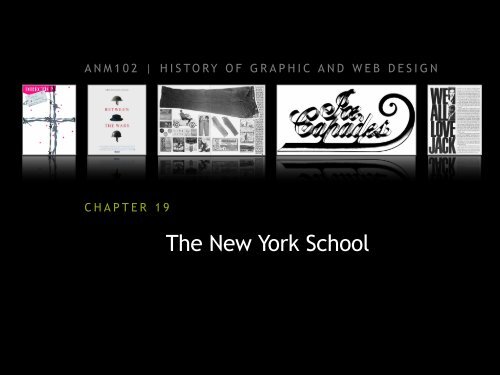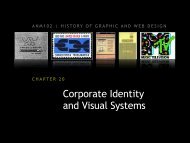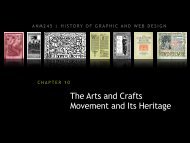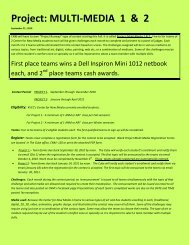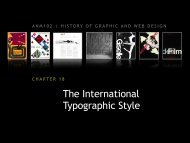chapter 19: the new york school - ANM102 History of Graphic and ...
chapter 19: the new york school - ANM102 History of Graphic and ...
chapter 19: the new york school - ANM102 History of Graphic and ...
- No tags were found...
Create successful ePaper yourself
Turn your PDF publications into a flip-book with our unique Google optimized e-Paper software.
<strong>ANM102</strong> | HISTORY OF GRAPHIC AND WEB DESIGNCHAPTER <strong>19</strong>The New York School
THE NEW YORK SCHOOL• European designers, escaping <strong>the</strong> political climate, immigrated to <strong>the</strong>United States <strong>and</strong> became major influences in <strong>the</strong> American designmovement.• European design was fairly <strong>the</strong>oretical <strong>and</strong> structured, whereAmerican design was pragmatic, intuitive <strong>and</strong> less formal in itsapproach to organizing space.• New York was <strong>the</strong> center <strong>of</strong> <strong>the</strong> movement in <strong>the</strong> <strong>19</strong>40s.• Emphasis was placed on <strong>the</strong> expression <strong>of</strong> ideas <strong>and</strong> an open, directpresentation <strong>of</strong> information.William Pickering, title page for <strong>the</strong>Book <strong>of</strong> Common Prayer, 1844.CHAPTER <strong>19</strong>: THE NEW YORK SCHOOL2
POSTER DESIGNPaul R<strong>and</strong>• style <strong>of</strong>ten reflectedentertaining puns<strong>and</strong> wordplay• played withcontrasts: red againstgreen, organicagainst geometric,cut or torn edgesagainst sharp forms,<strong>and</strong> textural patternagainst white• http://www.paul-r<strong>and</strong>.com/site/posters/William Pickering, title page for <strong>the</strong>Book <strong>of</strong> Common Prayer, 1844.CHAPTER <strong>19</strong>: THE NEW YORK SCHOOL4
PUBLICATIONPaul R<strong>and</strong>• Created this coverfor Directionmagazine, <strong>19</strong>40• red dots aresymbolically areinterpreted asholiday decorationsor blood dropsWilliam Pickering, title page for <strong>the</strong>Book <strong>of</strong> Common Prayer, 1844.CHAPTER <strong>19</strong>: THE NEW YORK SCHOOL5
PUBLICATIONAlvin Lustig• graphic designer,architect, <strong>and</strong>interior designer• became <strong>the</strong> visualdesign researchdirector at LookMagazine• heavily involved withdesign education <strong>and</strong>in <strong>19</strong>51 helpeddevelop a graduategraphic designprogram at YaleUniversityWilliam Pickering, title page for <strong>the</strong>Book <strong>of</strong> Common Prayer, 1844.CHAPTER <strong>19</strong>: THE NEW YORK SCHOOL6
LAYOUTBradbury Thompson• one <strong>of</strong> <strong>the</strong> mostinfluential designers <strong>of</strong>postwar America• had a thoroughknowledge <strong>of</strong> printing<strong>and</strong> typesetting <strong>and</strong>experimented withboth with great success• turned to classicapproach to book <strong>and</strong>editorial designfocusing on readability,formality, <strong>and</strong> Old Styletypefaces.• Worked for Smithsonian<strong>and</strong> ART<strong>new</strong>sWilliam Pickering, title page for <strong>the</strong>Book <strong>of</strong> Common Prayer, 1844.CHAPTER <strong>19</strong>: THE NEW YORK SCHOOL7
FILM AND LOGO DESIGNSaul Bass• opened a studio in LosAngeles in <strong>the</strong> <strong>19</strong>50s• greatly influenced byPaul R<strong>and</strong>• decorative letterformsare combined withtypography orh<strong>and</strong>writing• <strong>of</strong>ten used irregularforms drawn with abrush or cut from paper• like R<strong>and</strong>, designedsome well known logosWilliam Pickering, title page for <strong>the</strong>Book <strong>of</strong> Common Prayer, 1844.CHAPTER <strong>19</strong>: THE NEW YORK SCHOOL8
FILM PROMOTIONSaul Bass• became <strong>the</strong>acknowledged master<strong>of</strong> film titles.• his work has inspiredmany contemporarydesigns both in print<strong>and</strong> in <strong>the</strong> film industry• http://www.youtube.com/watch?v=z25t-PQDn5A&feature=relatedhttp://www.youtube.com/watch?v=rD6dDzUTJJ0&NR=1William Pickering, title page for <strong>the</strong>Book <strong>of</strong> Common Prayer, 1844.CHAPTER <strong>19</strong>: THE NEW YORK SCHOOL9
LOGO DESIGNIvan Chermayeff• began his career as arecord album designerwho coined <strong>the</strong> phrase"problem solving” inrelation to design• known for his logodesigns <strong>and</strong> whimsicalcollagesWilliam Pickering, title page for <strong>the</strong>Book <strong>of</strong> Common Prayer, 1844.CHAPTER <strong>19</strong>: THE NEW YORK SCHOOL10
POSTERIvan Chermayeff• Between <strong>the</strong> Wars,<strong>19</strong>77• interwar years arerepresented byChurchill’s hat betweentwo helmetsWilliam Pickering, title page for <strong>the</strong>Book <strong>of</strong> Common Prayer, 1844.CHAPTER <strong>19</strong>: THE NEW YORK SCHOOL11
LAYOUTRobert Brownjohn• New York designer• best known for motionpicture title sequences• worked for ColumbiaRecords designingjackets (Rolling Stones)• founding partner <strong>of</strong>Brownjohn, Chermayeff<strong>and</strong> Geisman Agency,just known asChermayeff & GeismantodayWilliam Pickering, title page for <strong>the</strong>Book <strong>of</strong> Common Prayer, 1844.CHAPTER <strong>19</strong>: THE NEW YORK SCHOOL12
AD AGENCIESDoyle Dane Bernbach• founded in <strong>19</strong>49 byJames Edwin Doyle,Maxwell Dane, <strong>and</strong> BillBernbach• one <strong>of</strong> <strong>the</strong> largestinternationally knownadvertising agenciestoday• considered to be <strong>the</strong>original “Mad Men”• created some <strong>of</strong> <strong>the</strong>most iconic layouts <strong>of</strong><strong>the</strong> centuryWilliam Pickering, title page for <strong>the</strong>Book <strong>of</strong> Common Prayer, 1844.CHAPTER <strong>19</strong>: THE NEW YORK SCHOOL14
MAGAZINEOtto Storch• notable magazine artdirector for McCalls• revolutionized <strong>the</strong>visual organization <strong>of</strong>magazine page layout• known for mergingphotography <strong>and</strong> wordsinto a dynamic visualideaWilliam Pickering, title page for <strong>the</strong>Book <strong>of</strong> Common Prayer, 1844.CHAPTER <strong>19</strong>: THE NEW YORK SCHOOL15
MAGAZINEMike Salisbury• pages from West,late <strong>19</strong>60s• here <strong>the</strong> art directorbecame a visualhistorian, researching<strong>and</strong> selecting oldLevi’s advertisements<strong>and</strong> products for apictorial essayWilliam Pickering, title page for <strong>the</strong>Book <strong>of</strong> Common Prayer, 1844.CHAPTER <strong>19</strong>: THE NEW YORK SCHOOL16
MAGAZINEGeorge Lois• prolific New Yorkgraphic designer• worked for severalmajor clients: MTV,Lean Cuisine, JiffyLube, ESPN...• designed over 30covers for EsquireMagazine• http://www.georgelois.com/index.htmlWilliam Pickering, title page for <strong>the</strong>Book <strong>of</strong> Common Prayer, 1844.CHAPTER <strong>19</strong>: THE NEW YORK SCHOOL17
TYPOGRAPHYHerb Lubalin• American graphic designer• graduate <strong>of</strong> Cooper Union• created two well-knownpublications, Avant Garde<strong>and</strong> Upper & Lower Case• designed Avant Garde font• turned typography into anart form <strong>and</strong> a powerfulcommunicative elementWilliam Pickering, title page for <strong>the</strong>Book <strong>of</strong> Common Prayer, 1844.CHAPTER <strong>19</strong>: THE NEW YORK SCHOOL18
TYPOGRAPHYHerb LubalinWilliam Pickering, title page for <strong>the</strong>Book <strong>of</strong> Common Prayer, 1844.CHAPTER <strong>19</strong>: THE NEW YORK SCHOOL<strong>19</strong>
LOGOHerb Lubalin• proposed New York City logo, <strong>19</strong>66• Isometric perspective creates a dynamictension between two- <strong>and</strong> three-dimensionalitywhile implying <strong>the</strong> city’s high-rise architectureWilliam Pickering, title page for <strong>the</strong>Book <strong>of</strong> Common Prayer, 1844.CHAPTER <strong>19</strong>: THE NEW YORK SCHOOL20
TYPOGRAPHYHerb Lubalin• Ice Capades logo,<strong>19</strong>67William Pickering, title page for <strong>the</strong>Book <strong>of</strong> Common Prayer, 1844.CHAPTER <strong>19</strong>: THE NEW YORK SCHOOL21
MAGAZINEHerb Lubalin• pages from Eros, <strong>19</strong>62• Lubalin overlapped <strong>and</strong>touched letterforms,compressed <strong>the</strong> spacebetween words, <strong>and</strong>squeezed words <strong>and</strong>images into a rectangleWilliam Pickering, title page for <strong>the</strong>Book <strong>of</strong> Common Prayer, 1844.CHAPTER <strong>19</strong>: THE NEW YORK SCHOOL22
KEY PEOPLE• Paul R<strong>and</strong>• Bill Bernbach• Alvin Lustig• BradburyThompson• Saul Bass• George Tscherny• Robert Brownjohn• Ivan Chermayeff• Thomas H.Geismar• Norman Ives• Leo Lionni• Alex<strong>and</strong>erLiberman• Cipe Pineles• Otto Storch• Henry Wolf• Peter Palazzo• Dugald Stermer• Bea Feitler• Michael Salisbury• Doyle DaneBernbach Agency• Bob GAgeWilliam Pickering, title page for <strong>the</strong>Book <strong>of</strong> Common Prayer, 1844.• Phyllis Robinson• Alcorn• Gene Frederico• Rondthaler• Herb Lubalin• George LoisCHAPTER <strong>19</strong>: THE NEW YORK SCHOOL23
KEY TERMSBrownjohn, Chermayeff, <strong>and</strong> GeismarThe initial contribution <strong>of</strong> <strong>the</strong>se three to Americangraphic design sprang from a strong aes<strong>the</strong>ticbackground <strong>and</strong> an underst<strong>and</strong>ing <strong>of</strong> <strong>the</strong> major ideas<strong>of</strong> European modern art. A communicative immediacy,a strong sense <strong>of</strong> form, <strong>and</strong> a vitality <strong>and</strong> freshnesscharacterized <strong>the</strong>ir work in <strong>the</strong> early months <strong>of</strong> <strong>the</strong>partnership. Images <strong>and</strong> symbols were combined witha surreal sense <strong>of</strong> dislocation to convey <strong>the</strong> essence <strong>of</strong><strong>the</strong> subject on book jackets <strong>and</strong> posters. A fine sense<strong>of</strong> both typography <strong>and</strong> art history enabled <strong>the</strong>m tosolve problems through inventive <strong>and</strong> symbolicmanipulation <strong>of</strong> forms <strong>and</strong> imagery. Solutions grew out<strong>of</strong> <strong>the</strong> needs <strong>of</strong> <strong>the</strong> client <strong>and</strong> <strong>the</strong> limitations <strong>of</strong> <strong>the</strong>problem at h<strong>and</strong>.Visual/verbal syntaxword <strong>and</strong> image fused into a conceptual expression <strong>of</strong>an idea so that <strong>the</strong>y become completelyinterdependent, <strong>the</strong> Bernbach approach evolved during<strong>the</strong> <strong>19</strong>50s <strong>and</strong> <strong>19</strong>60s by Bill Bernbach at <strong>the</strong> New Yorkadvertising agency Doyle Dane Bernbach.“The <strong>new</strong> advertising,”In <strong>new</strong>, small boutique advertising agencies emphasiswas placed on creativity ra<strong>the</strong>r than on full marketingservices. An attempt was made to create more honest,literate, <strong>and</strong> tasteful appeals to <strong>the</strong> market audience.Figurative typographya playful direction taken by New York graphic designersduring <strong>the</strong> <strong>19</strong>50s <strong>and</strong> <strong>19</strong>60s. This approach,spearheaded by Gene Frederico took many forms:letterforms became images, such as <strong>the</strong> wheels in <strong>the</strong>Frederico’s ad for Woman’s Day, or <strong>the</strong> visualproperties <strong>of</strong> words <strong>the</strong>mselves, or <strong>the</strong>ir organizationin space, were used to express an idea, such as in DonEgensteiner’s “Tonnage” advertisement,in which <strong>the</strong> visual form <strong>of</strong> <strong>the</strong> word takes on aconnotative meaning.William Pickering, title page for <strong>the</strong>Book <strong>of</strong> Common Prayer, 1844.CHAPTER <strong>19</strong>: THE NEW YORK SCHOOL24
KEY TERMSPhototypography<strong>the</strong> setting <strong>of</strong> type by exposing negatives <strong>of</strong> alphabetcharacters to photographic paper dawned in <strong>19</strong>25 with<strong>the</strong> public announcement <strong>of</strong> <strong>the</strong> Thothmicphotographic composing machine invented by E. K.Hunter <strong>and</strong> J. R. C. August <strong>of</strong> London. A keyboardproduced a punched tape to control a long, opaquemaster film with transparent letterforms. As a givenletter moved in position in front <strong>of</strong> a lens, it wasexposed to photographic paper by a beam <strong>of</strong> light.International TypefaceCorporation (ITC)established by Aaron Burns, thirty-four fully developedtype families <strong>and</strong> about sixty additional display faceswere designed <strong>and</strong> licensed during its first decade. Itsfonts had large x-heights <strong>and</strong> short ascenders <strong>and</strong>descenders; <strong>the</strong>se became <strong>the</strong> prevailingcharacteristics <strong>of</strong> fonts designed during <strong>the</strong> <strong>19</strong>70s <strong>and</strong>early <strong>the</strong> <strong>19</strong>80s.Typogrambrief, visual typographic form in which concept <strong>and</strong>visual form are merged into a oneness.William Pickering, title page for <strong>the</strong>Book <strong>of</strong> Common Prayer, 1844.CHAPTER <strong>19</strong>: THE NEW YORK SCHOOL25


